Are Woolly Bears Winter Predictors?
Fall is prime time to see the infamous woolly bear: The furry, black-and-red-banded caterpillar of the Isabella tiger moth. These caterpillars are known for showing up in the fall under leaves and on road surfaces as they search for a spot to overwinter. They have a defense mechanism of curling into a tight, bristly ball when disturbed.
Facts:
- The caterpillar’s coloring is determined by factors like its age, species, and the length of the growing season.
- A larger brown band suggests a good growing season, as the caterpillar had more time to feed and grow.
- The color patterns can vary significantly from one caterpillar to another, even in the same area, making it an inconsistent predictor.
Folklore:
- Black band wider at the head: The beginning of winter will be harsh.
- A black band wider at the tail: The end of winter will be harsh.
- More black on the woolly bear means a more severe winter; more brown means a milder winter.
- Timing: The position of the longest black stripe (front or back) indicates the timing of the harshest weather
Lifecycle: After overwintering, the caterpillar forms a cocoon in the spring, pupates, and emerges as an adult Isabella tiger moth, which then lays eggs to start the cycle again

Hennepin County Plans North Arm Access Improvements
The redesign of the North Arm Public Access on Lake Minnetonka in Orono will repair important infrastructure and improve user access.
According to the Hennepin County website, the project will:
- Repair structural deterioration and asphalt conditions.
- Realign the boat launch and angle the parking stalls to improve navigation in the parking lot.
- Add access for users in human-powered crafts like canoes, kayaks, and paddleboards.
- Better accessibility, sightlines, lighting and “pods” that extend out into the lake for a better shoreline fishing experience.
- Redesign the storm water management system and add solar.
For more information about the timeline and feedback opportunities, visit the website
A Facelift for the Lake Minnetonka Regional Trail:
In early November, parts of the Lake Minnetonka Regional Trail west of Excelsior received a fresh surface. Crews added and compacted roughly 5–6 inches of fine gravel, giving trail users a smoother and more comfortable ride or walk.
Was this post useful?
Average rating 5 / 5. Vote count: 6
No votes so far! Be the first to rate this post.















